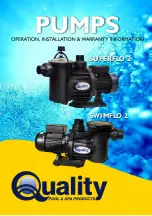
ULTRA-FLO MY3-50 METAL - Simplify Your Maintenance
Assembly, Installation & Operation Manual | www.qmax.com.my
8
Symptoms
Potential Cause(s):
Recommendation(s):
Pump Cycles
Running Sluggish
/ Stalling, Flow
Unsatisfactory
(cont.)
Air supply pressure or volume
exceeds system hd.
Decrease inlet air (press. and vol.) to the pump. Pump is cavitating the
fluid by fast cycling.
Undersized suction line.
Meet or exceed pump connections.
Restrictive or undersized air line. Install a larger air line and connection.
Suction side air leakage or air in
product.
Visually inspect all suction-side gaskets and pipe connections.
Suction line is blocked.
Remove or flush obstruction. Check and clear all suction screens or
strainers.
Pumped fluid in air exhaust
muffler.
Disassemble pump chambers. Inspect for diaphragm rupture or loose
diaphragm plate assembly.
Check valve obstructed.
Disassemble the wet end of the pump and manually dislodge
obstruction in the check valve pocket.
Check valve and/or seat is worn
or needs adjusting.
Inspect check valves and seats for wear and proper setting. Replace if
necessary.
Entrained air or vapor lock in
chamber(s).
Purge chambers through tapped chamber vent plugs. Purging the
chambers of air can be dangerous.
Product Leaking
Through Exhaust
Diaphragm failure, or diaphragm
plates loose.
Replace diaphragms, check for damage and ensure diaphragm plates
are tight.
Diaphragm stretched around
center hole or bolt holes.
Check for excessive inlet pressure or air pressure. Consult Chemical
Resistance Chart for compatibility with products, cleaners, temperature
limitations and lubrication.
Premature
Diaphragm Failure
Cavitation.
Enlarge pipe diameter on suction side of pump.
Excessive flooded suction
pressure.
Move pump closer to product. Raise pump/place pump on top of tank to
reduce inlet pressure. Install Back pressure device (Tech bulletin 41r).
Add accumulation tank or pulsation dampener.
Misapplication (chemical/physical
incompatibility).
Consult Chemical Resistance Chart for compatibility with products,
cleaners, temperature limitations and lubrication.
Incorrect diaphragm plates or
plates on backwards, installed
incorrectly or worn.
Check Operating Manual to check for correct part and installation.
Ensure outer plates have not been worn to a sharp edge.
Unbalanced
Cycling
Excessive suction lift.
For lifts exceeding 20’ of liquid, filling the chambers with liquid will prime
the pump in most cases.
Undersized suction line.
Meet or exceed pump connections.
Pumped fluid in air exhaust
muffler.
Disassemble pump chambers. Inspect for diaphragm rupture or loose
diaphragm plate assembly.
Suction side air leakage or air in
product.
Visually inspect all suction-side gaskets and pipe connections.
Check valve obstructed.
Disassemble the wet end of the pump and manually dislodge
obstruction in the check valve pocket.
Check valve and/or seat is worn
or needs adjusting.
Inspect check valves and seats for wear and proper setting. Replace if
necessary.
Entrained air or vapor lock in
chamber(s).
Purge chambers through tapped chamber vent plugs.
TROUBLESHOOTING GUIDE
(CONT.)






























